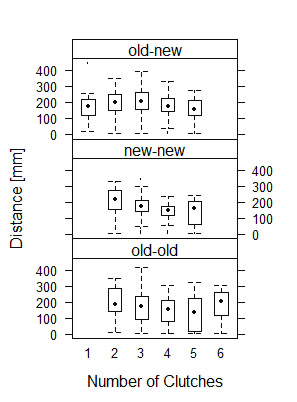
Ecological Archives E096-081-A2
Jörg G. Stephan, Johan A. Stenberg, and Christer Björkman. 2015. How far away is the next basket of eggs? Spatial memory and perceived cues shape aggregation patterns in a leaf beetle. Ecology 96:908–914. http://dx.doi.org/10.1890/14-1143.1
Appendix B. Decreasing distance with increasing number of clutches and believed oviposition pattern.
Fig. B1. Box plot of intra-plant distances between clutches depending on the number of clutches on a plant. Irrespective of plant genotype, the mean distance between clutches was dependent on the number of clutches on one shoot (Linear mixed model with plant as random effect: clutch number: Chi-square = 14.2, df = 1, p < 0.001; plant species: Chi-square = 1.1, df = 1, p = 0.29; clutch number × plant species: Chi-square = 0.7, df = 1, p = 0.38).
Fig. B2. Original distances between clutches from all plants. These distances were standardized by the number of clutches on a plant and further divided by the total plant leaf area of each plant (Mean, SD, Min, Max leaf area (mm²) of one leaf: S. viminalis: 2186, 450, 1047, 3469; S. dasyclados: 4880, 1591, 1518, 10260).
Fig. B3. Example calculation of believed oviposition patterns for each female during the experiment with four females (all spent the same amount of time on a plant, and fewer eggs implies a lower oviposition rate (OR)). The first females laid the same number of eggs, but subsequent females laid fewer. (a) The OR decreases with increasing number of eggs on a plant. (b) The OR decreases with number of conspecifics visiting a plant; the number of conspecifics increases faster on the new host then on the mixed hosts and, therefore, the OR decrease was greater in the new hosts treatment. (c) The cumulative OR decreases due to number of eggs and due to number of conspecifics. (d) The observed highest egg numbers in the mixed hosts treatment must originate from a higher OR although the egg number on a plant was increasing, otherwise mixed hosts would have received as many eggs as the same host treatment. Therefore, females in this treatment must have ranked the preferred intermediate conspecific density higher than the higher number of eggs on a plant.